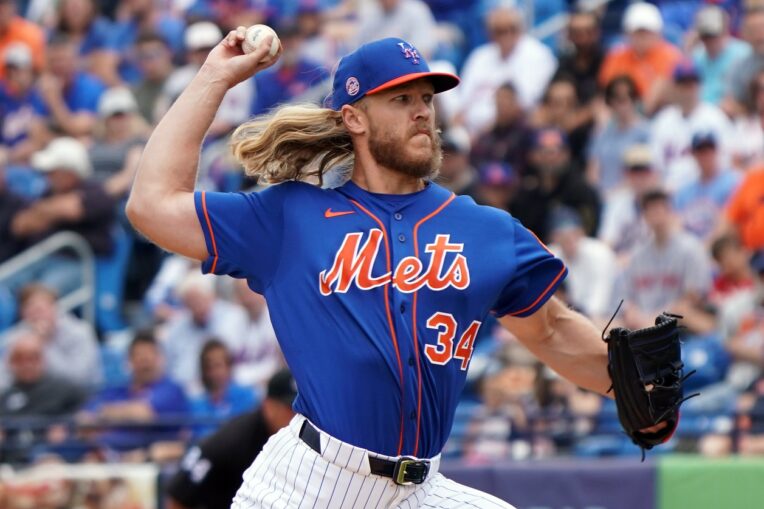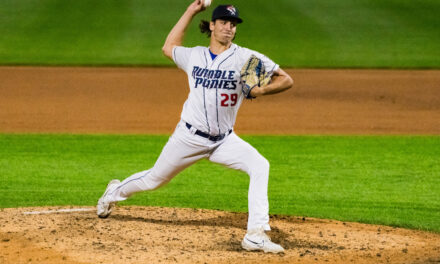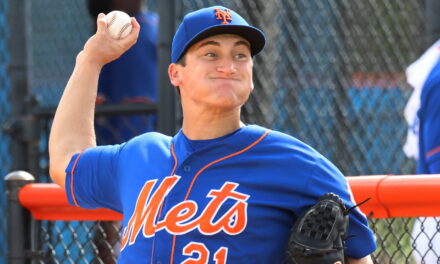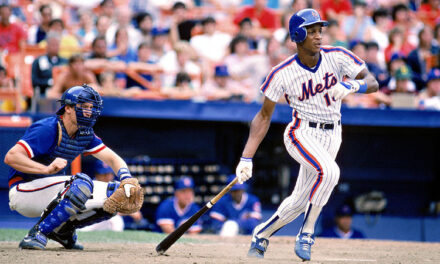
New York Mets pitchers Noah Syndergaard and J.T. Ginn were seen playing catch together on Friday, which is a big first step in their recovery from Tommy John surgery.
Syndergaard posted a video to his Instagram page of he and Ginn throwing the ball around at a short distance.
https://www.instagram.com/p/CDUX5W6hOUr/?utm_source=ig_web_copy_link
“Thank you to everyone at @cresseysportsperformance and @csp_phystherapy for getting the young gun @jtginn3 and I this far. Four and a half months goes by fast when the world is burning,” Syndergaard wrote in the post.
The man behind the account @csp_phystherapy is none other than Eric Schoenberg, head of Diamond Physical Therapy located inside Cressey sports performance in Palm Beach, Florida, where Syndergaard and Ginn have spent their days rehabbing.
“I’ve seen guys throw after 16 weeks or not until 24 weeks. They are both (Syndergaard and Ginn) a little ahead of schedule but the work they’ve put in with their strength and range of motion testing is how they got here. All parties were comfortable with them starting to throw on Friday,” Schoenberg told Metsmerized in a phone interview.
According to Schoenberg, Syndergaard has been training at Cressey for the past several years and did so this off-season leading up to spring training in February.
As major league spring training facilities are shutdown this year during the regular season due to Covid-19, Cressey has taken on a slew of major and minor league players rehabbing their injuries.
While the Mets site at Port St. Lucie remains closed, Schoenberg has been with Syndergaard since the day after his surgery in March and they’ve been attacking the rehab process ever since.
“We have a plan for the next 8 months leading up until spring training with information from all parties in the decision making. It’s a slow turn and is all based on week-to-week progress moving forward. It will be a low volume effort level for the next 6-8 weeks, and then it trends up from there. As the months progress, there are gradual additions. You don’t add sinkers, curveballs, throwing off the mound, or bullpens all at once. You have to limit the variables so that if there is any irritation from the elbow or shoulder you know what caused it and how to adjust the program. That’s how you eliminate any big setbacks. You go off good weeks.”
“There’s nothing but nice easy tossing in the beginning. They will not stress the ligament in the near future and will slowly build out the distance and number of throws per session. They will just be playing catch. Every month we think about adding stuff that’s mapped out in the program. There’s a long road ahead and a lot of goals to reach and right now, we just hit a big one. For Noah, after 18 weeks of rehab coming in everyday, to be able to put a baseball in his hand was a huge accomplishment,” said Schoenberg.

Schoenberg says in Syndergaard’s case, they are focused on moving away from adding bulk and muscle by shifting their attention to increasing his limberness and athleticism to prevent future injury to the joint ligament.
“We believe the primary cause of the UCL tear could be that he has such a high average fastball velocity (and has for a long time), so going forward we agreed that improving the mobility of his joints and soft tissue, along with improving his athleticism and rotational power would help reduce stress to the arm upon his return to pitching,” said Schoenberg.
By gaining strength, Schoenberg believes Syndergaard may have lost a little bit of fluidity and movement becoming stiffer and less rotational and athletic. While he was clear that he does not think there is any direct correlation, the physical therapist was adamant that it could cause a pitcher to lose some mobility, which may have been a factor in his joint getting stressed.
Luckily, Schoenberg says Syndergaard has been on board with the rehab process from day one, attacking every rep with the utmost competitiveness. While at the same time, understanding how his body feels and making educated decisions based off the adequate information that’s presented to him. He’s incredibly motivated and wants to utilize his rehab in order to become a better pitcher, per Schoenberg.
“We have a period to get things right including the mobility in his hips, the tightness of his body, and the stability of his shoulder, which needed to be addressed so he could be more fluid with his delivery,” said Schoenberg.
Despite having a long way to go in the rehab process, Syndergaard and Ginn have passed every test to get to this point and are progressing nicely. The hope is, that they will both be back with the Mets organization by early next season contributing at their respective levels.














